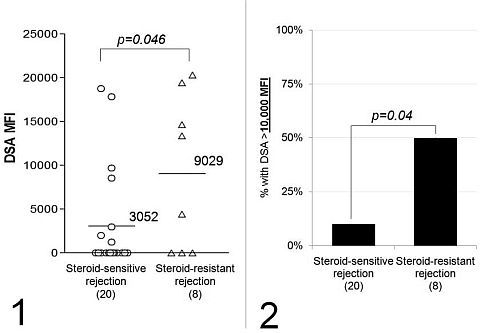High DSA Is Associated with Steroid-Resistant Rejections in Liver Transplantation
UCLA, Los Angeles, CA
Terasaki Foundation Laboratory, Los Angeles, CA
Meeting: 2013 American Transplant Congress
Abstract number: D1607
Aim: To determine the prevalence of DSA in acute rejection episodes after liver transplantation and its role as a predictor of clinical response to treatment.
Methods: 28 adult liver transplant recipients with biopsy-proven acute rejection between March 2011 and October 2012 were included in the study. Serum samples at the time of acute rejection were used to examine the presence of DSA, and MFI >1000 was considered positive. The mean recipient age was 51 yrs old, 57% were females, and 86% received a primary liver transplant. 25% received a liver transplant for HCV cirrhosis, 25% for autoimmune liver conditions and 18% for alcoholic liver disease. The mean time from transplant to acute rejection was 26 months (±45 months).
Results: 12 of 28 patients (43%) had DSA at the time of biopsy-proven acute rejection. All DSAs were against HLA class II antigens. 5 patients had only 1 DSA, 4 patients had 2 DSAs, and 3 patients had 3 DSAs. 8 patients had anti-DQ DSA, 7 patients had anti-DRB345 DSA and 1 patient had anti-DRB1 DSA. The median MFI of the highest DSA was 9130 (range: 1238-20320). 4 patients had DSA between 1000-4999 MFI, 2 patients between 5000-9999 MFI, and 6 over 10,000 MFI. 20 episodes of rejection showed good clinical resolution after treatment with IV steroids (steroid-sensitive rejections [SSR]), while 8 cases needed extra treatment to achieve resolution (steroid-resistant rejections [SRR]). For SRR, ATG was used in 6 cases, rituximab alone in 1 case, and rituximab plus bortezomib in 1 case. DSA >1000 MFI was detected in 5 of 8 (63%) cases of SRR and in 7 of 20 cases of SSR (35%). Patients with SRR showed significantly higher DSA MFI than cases of SSR (9029 MFI vs. 3052 MFI, p=0.046, fig 1). Moreover, 50% of SRR showed DSA >10,000 MFI, compared to only 10% in patients with SSR (p=0.04, fig 2).

Conclusions: DSA was found in 43% of patients with biopsy-proven acute rejection. Patients with SRR exhibit higher MFI DSA than SSR. Presence of DSA and their strength may be used as a biomarker to predict response to anti-rejection treatment thus prospectively guiding the vigilance with which they need to be treated.
Terasaki, P.: Stockholder, One Lambda, Inc.
To cite this abstract in AMA style:
Kaneku H, Zarrinpar A, Terasaki P, Busuttil R. High DSA Is Associated with Steroid-Resistant Rejections in Liver Transplantation [abstract]. Am J Transplant. 2013; 13 (suppl 5). https://atcmeetingabstracts.com/abstract/high-dsa-is-associated-with-steroid-resistant-rejections-in-liver-transplantation/. Accessed December 17, 2025.« Back to 2013 American Transplant Congress
